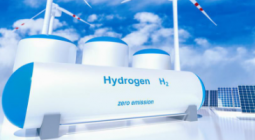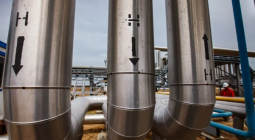Don't believe hydrogen and nuclear hype – they can’t get us to net zero carbon by 2050

Big industry players pushing techno-fixes are ignoring the only realistic solution to the climate crisis: renewables
Now that the whole world seems to be aligned behind the goal of net zero carbon emissions by 2050, the nuclear industry is straining every sinew to present itself as an invaluable ally in the ambitious aim. Energy experts remain starkly divided on whether or not we can reach this global net zero target without nuclear power, but regardless, it remains a hard sell for pro-nuclear enthusiasts.
The problems they face are the same ones that have dogged the industry for decades: ever-higher costs, seemingly inevitable delays, no solutions to the nuclear waste challenge, security and proliferation risks.
The drawbacks to nuclear are compounded by the burgeoning success of renewables – both solar and wind are getting cheaper and more efficient, year after year. There is also a growing realisation that a combination of renewables, smart storage, energy efficiency and more flexible grids can now be delivered at scale and at speed – anywhere in the world.
While the majority of environmentalists continue to oppose nuclear power, there is now a significant minority, increasingly concerned about accelerating climate change, who just don’t see how we can get to that net zero comfort zone without it. They’re right to be concerned – it is a truly daunting challenge. All emissions of greenhouse gases (across the entire economy, including those from transport, heating, manufacturing and refining, farming and land use, as well as from shipping and aviation) must be brought down to as close to zero as possible, with all residual emissions compensated for by the removal of an equivalent amount of CO2 from the atmosphere.
It’s the sheer scale of that challenge that has led a lot of people (including Boris Johnson with the government’s 10-point plan in November) not just to keep a flag flying for the nuclear industry, but to revisit the idea of hydrogen doing some of the heavy lifting. Hydrogen hype has become all the rage over the last 18 months, with some offering up this “clean energy technology”, as government officials insist on describing it, as the answer to all our net zero prayers.
For those prayers to be answered, there will need to be a complete revolution in the way in which hydrogen is produced. As it is, 98% of the 115m tonnes used globally is “grey hydrogen”, made from natural gas or coal, that emits around 830m tonnes of CO2 per annum – 2% of total global greenhouse gas emissions. Beyond that, there’s a tiny amount of so-called “blue hydrogen” – essentially grey hydrogen but with its CO2 emissions captured and stored – and an even tinier amount of “green hydrogen” from electrolysing water, both of which are much more expensive than the climate-wrecking grey hydrogen.
The gulf between that current reality, one rarely mentioned by hydrogen enthusiasts, and the prospect of readily available and affordable green hydrogen that could help us get to net zero, is absolutely vast.
Don’t get me wrong: we will indeed need significant volumes of green hydrogen and it’s good that the government has set an ambitious target for 2030, in the hope that this will significantly reduce the costs of electrolysis to create it. But we need to be clear about what that green hydrogen should be used for: not for electricity; not for heating homes and non-domestic buildings; and not for cars, where electric vehicles will always be better. Instead we will need it for what are called the “hard-to-abate” sectors: for steel – replacing carbon-intensive coking coal – cement and shipping.
Much of the hype for hydrogen is coming from the oil and gas sector, in the hope that gullible politicians, seduced by an unattainable vision of limitless green hydrogen, will subsidise the vast investments needed to capture the emissions from gas-powered hydrogen. Their motivation couldn’t be clearer: to postpone the inevitable decline of their industry.
The nuclear industry is also desperate to get in on that game. One has to admire its capacity to pivot opportunistically. In February, the Nuclear Industry Council (made up of both industry and government representatives in the UK) published a shiny new Hydrogen Roadmap, exploring how either large-scale nuclear or small modular reactors could generate both the electricity and the heat needed to produce large amounts of green hydrogen. But the entire plan is premised on spectacular and totally speculative reductions in the cost of electrolysis.
Rather than being the solution we have been waiting for, this nuclear/hydrogen development would actually be a disastrous techno-fix. Low-carbon nuclear power will always be massively more expensive than renewables and we can never build enough reactors to replace those coming offline over the next decade. We also know that producing hydrogen is always going to be very expensive. The truth is, you need a lot of electricity to produce not a lot of hydrogen. All of which makes pipe-dreams about substituting hydrogen for conventional gas in the UK’s gas grid, or of producing millions of tonnes of blue hydrogen, look almost entirely absurd.
This, then, could lead to a double economic whammy of quite monstrous proportions. It would either have to be paid for through general taxation or through higher bills for consumers. That’s particularly problematic from the perspective of the 10% of households in England still living in cruel and degrading fuel poverty.
Environmentalists who are tempted by this new nuclear/hydrogen hype should remember that our transition to a net zero world has to be a just transition. Every kilowatt hour of nuclear-generated power will be a much more expensive kilowatt hour than one delivered from renewables plus storage.
So let’s just hold back on both the hydrogen hype and the nuclear propaganda, and concentrate instead on ramping up what we already know is cost-effectively deliverable: renewables. We need to do it as fast as we possibly can.
-
Jonathon Porritt is an environmentalist and founder-director of Forum for the Future. His latest book is Hope in Hell: A Decade to Confront the Climate Emergency
16 March 2021
The Guardian




